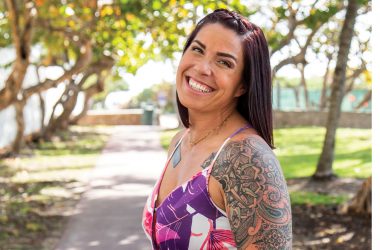Farm-to-table dining isn’t just for trendy restaurants anymore. Here’s how to bring this popular movement to your kitchen table
When he’s not in the kitchen, Kevin Templeton, executive chef of three popular San Diego eateries, can often be found strolling through one of the city’s farmer’s markets to source local food for his restaurants. As the chef of barleymash, Smoking Gun and Spill the Beans, Templeton says that in San Diego County, “we’re fortunate to have year-round access to beautiful farm-fresh products.
“I think there’s at least one farmer’s market every day somewhere in the area,” he said. His go-to company is Specialty Produce, a market near the city’s Old Town area that is open to the public. “It’s basically the best produce you can get in one location,” he says. It’s farm-to-table at its very best.”
Meanwhile, on the East Coast, Chef Brian Poe tends to his backyard garden in Danvers, MA, where he cultivates more than a dozen different herbs and a wide array of vegetables for use in his Boston restaurants. He fills in what he can’t grow with seasonal fruit and vegetables from his favorite local farmers. “I never have to buy any produce at the big chain supermarkets,” he says. “I walk outside, pick, rinse and eat,” says Poe, who uses his plants as garnishes at all three of his restaurants: Parish Café, Tip Tap Room and Bukowski’s Cambridge.
“It took me a few years to get the real rhythm of the constantly changing New England weather, but now, I’ve got my very own farm-to-table movement going for a few months of mid-Summer to early Fall,” he says.
The farm-to-table movement – which promotes eating food made from locally sourced, seasonal ingredients, often natural or organic – has long been touted by chefs like Templeton and Poe in their restaurants. And the movement, which has become increasingly popular among those who appreciate seasonal fare as well as those concerned with protecting the environment and supporting their local economy, has seeped into households.
“This isn’t just a movement for foodies who eat at nice restaurants,” Templeton says. “For many people, it’s become a lifestyle that they want to carry on in their households as well.”
Chef Poe’s Tomato Cucumber Salad
INGREDIENTS
- 6 oz. cucumbers, cored and sliced
- 3 oz. cherry tomatoes, sliced in half
- Shaved parmesan and sea salt (to taste)
- Cucumber dressing (see recipe)
Combine cucumbers, tomatoes and dressing in a small bowl. Top with shaved parmesan and a sprinkle of sea salt.
CUCUMBER DRESSING
- ½ cup chopped cucumber
- ½ tsp. basil leaves
- 1 T. dill
- 1 large garlic clove
- 1 T. lemon juice
- ¾ cup organic yogurt
- 1 T. olive oil
- ¼ tsp. salt
- 1 tsp. sugar
Place the cucumber, basil, dill and garlic in the bowl of a mini-chop or blender and process until creamy. Mix with the remaining ingredients.
SERVES 4
Good for You (& the Planet)
What’s driving the trend? For starters, seasonal food has better flavor, and it’s fresher and more nutritious than food consumed out of season. Take strawberries, for example. Even though many of us like to eat them all year round, the best time to eat strawberries is when they can be purchased directly from a local farm shortly after they’ve been harvested, when they’re juiciest and most flavorful.
What’s more, studies have shown that fruits and vegetables contain more nutrients when allowed to ripen naturally on their parent plant. A study, by the Leopold Center for Sustainable Agriculture, of 16 fruits and vegetables showed the average piece of produce was transferred nearly 1,500 miles before being sold. In addition, nearly 40 percent of fruit and more than 10 percent of vegetables in the study were imported from outside the United States. To keep foods from going bad during travel, sometimes they are picked before they are able to completely ripen and absorb nutrients. While this gives consumers access to fresh foods year-round, these fruits and vegetables sometimes lack nutrients that would be there if allowed to ripen before being picked and shipped, according to the Leopold Center.
Studies have shown that fruits and vegetables contain more nutrients when allowed to ripen naturally on their parent plant.
What’s more, eating farm-fresh foods is good for the environment. Purchasing locally grown foods helps support area farmers and maintain open space in your community. Plus, local growers can tell you exactly how the food was grown, including what types of pesticides they used. Simply put, when you know where your food comes from, you know a lot more about your food.
Farm to (Your) Table
You don’t have to be a notable chef to bring the farm to your table. The first step is to get acquainted with local farmer’s markets and organic food stores in your neighborhood. If you’re not sure what to buy, start by purchasing a few foods that you buy regularly and are simple to prepare.
When shopping at these markets, Chef Poe recommends checking out the names of the farms that are selling produce there and asking the farmer how you can buy from them more frequently. Even if you’re at a larger supermarket, such as Whole Foods, he says, many of these outlets post pictures of the farm or farmers that grew the produce. “See if you can find those farmers online and ask them how you can buy from them directly,” he suggests. Getting to know the farmers is helpful, he says, because they can give you knowledge you can trust.
Once you become familiar with your local farmer’s markets, you’ll begin to learn what’s in season in your geographical area. For example, in many areas of the country, early vegetables like asparagus and radishes are in season in the Spring, while Summer is the season for stone fruit (like peaches and apricots) and most berries, brussels sprouts and eggplant. Autumn is the season for heartier produce, like apples, pears, broccoli, cauliflower and kale; and root vegetables like turnips and sweet potatoes are in season in Winter. Chef Templeton recommends creating seasonal lists of fresh produce and planning simple recipes around what’s available. “My advice is to keep things very simple,” he says. “Let the produce do all of the work.
Don’t live near a local farm? Try growing some of your own produce, suggests Poe. Even if you only have a small patch of land, or a patio, you can grow your own produce. Experiment with something that grows fairly easily and quickly, and expand from there. Although Poe says he gardens on “a very small bit of land,” he’s able to plant and harvest about 37 different plants. “I’m able to walk outside my door in the summer and see that the chive blossoms are blooming or the strawberries are showing up,” he says. “It’s a wonderful feeling.”
Chef Templeton’s Lentil Pilaf
INGREDIENTS
- 3 T. coconut oil (divided)
- 3 T. minced shallots
- 2 cups chicken or vegetable stock
- 1 cup lentils, any color
- ¼ cup chopped cauliflower
- ¼ cup chopped carrots
- ¼ cup chopped onions
- ¼ cup chopped celery
- Salt and pepper, to taste
- Butter (optional)
DIRECTIONS
- Heat 1 tablespoon coconut oil in a saucepan and stir in shallots. Sauté shallots until they are a nice golden brown.
- Add stock (chicken or veggie) and bring to a boil.
- Stir in lentils and reduce heat to a low simmer. Simmer uncovered for 5 minutes or until lentils are tender but not too soft. Be aware: Different types of lentils take less or more time to cook.
- Drain excess liquid and set aside.
- Heat remaining 2 tablespoons coconut oil in a large sauté pan over high heat. Stir in cauliflower, carrots, onions and celery and sauté for 5 minutes or until tender.
- Add lentils and sauté for 2 more minutes.
- Season with salt and pepper.
- Stir in butter (if you like).
© mandy disher photography


